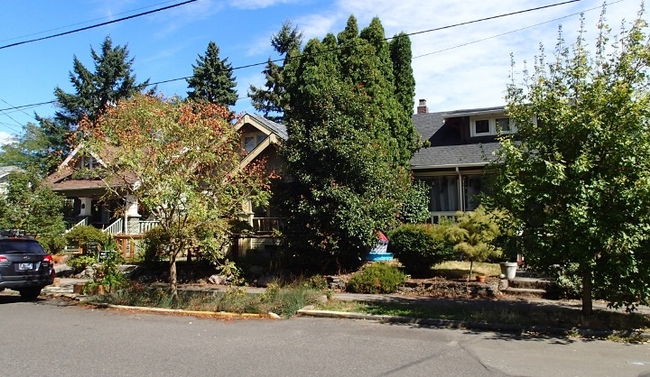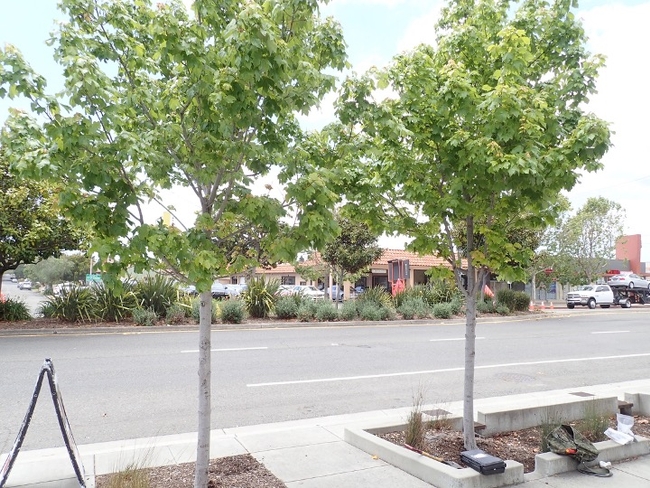The green leaves of the trees that line city streets soften the visual harshness of concrete and asphalt. Walking in the shade of their canopy, you may not think about how trees live in a small patch of soil surrounded by sidewalks and streets.
Behind every thriving street tree is science. Scientists evaluate trees to determine which species will grow well in a particular environment. Scientists study the best ways to protect the tree against pests and diseases. Scientists research how to prune the tree for the best performance.
“I think that the most overlooked and under-recognized value of trees is the subtle calming and healing effect that urban trees and natural green spaces have on people, and this effect is amplified once people become aware of it,” said Stephen Prée, environmental programs manager and city arborist for the City of El Cerrito. “While trees are calming and sublime, they are also busy at work removing pollutants from the soil and the air as they expel oxygen and moisture.”
“Our community uses our parks and natural areas as a vehicle for personal and community replenishment and revitalization. In the El Cerrito natural area, we see our community members relaxing in the shady ambience of a grove of trees, we see families or friends connecting with each other, we see volunteers working together to sustain native plant habitat,” said Prée, who is partnering with Igor Lacan, UC Cooperative Extension horticulture advisor for the Bay Area, on a study of streetside stormwater basins, or bioswales.
University of California Cooperative Extension horticulture advisors and specialists work with arborists, park superintendents, landscapers and many other professionals to support urban trees.
Trees can grow well in bioswales
Bioswales are built to contain stormwater that drains from homes and roads. When landscaped with trees, this green infrastructure provides several “ecosystem services,” says Lacan, such as filtering dust from the air, creating windbreaks, capturing stormwater runoff, muffling street noise, and providing habitat for birds and other wildlife. Some arborists are reluctant to plant trees in bioswales, concerned that the trees will fail if they don't have enough space to grow or get too much water in the winter and not enough water in the summer.
New research by Lacan shows trees can grow as well in bioswales as in other landscapes. To evaluate the performance of street trees, he monitored 23 tree species in 93 bioswales across five cities in the San Francisco Bay Area and in Portland, Ore., over five years.
Lacan's study showed that in the Bay Area trees grow well if they are irrigated in the summer, otherwise insufficient soil moisture may limit their growth. Importantly, he also found no evidence of waterlogging in the winter, thanks to quick drainage in the sandy soil. Although bioswale substrates tend to be composed of more sand than silt and clay, Lacan found the bioswale soils contain a comparable amount of plant nutrients to some other urban soils.
“Salinity isn't a problem unless de-icing salts are used,” said Lacan, who is part of the University of California Agriculture and Natural Resources or UC ANR. “It may become a problem where recycled water is used for irrigation, but routine soil tests are probably not needed unless the trees show symptoms of salinity or nutrient deficiency.”
A grant from UC ANR's California Institute for Water Resources enabled Lacan to start the bioswale study, and his successful research garnered additional funding from the U.S. Forest Service to continue the five-year study.
UC Master Gardeners take on BEaST
To share what he's learned, Lacan has enlisted UC Master Gardener volunteers in what he calls the Bioswale Education and Stewardship Training, or BEaST, project in Half Moon Bay. The UC Master Gardener Program is also part of UC ANR.
He is training UC Master Gardener volunteers to document trash and debris accumulation, and assess plant condition and soil texture, compaction, moisture and infiltration rate in bioswales. They report their observations via the smartphone app Survey 123 and a survey created by Lacan.
“That's the power of UC ANR,” Lacan said. “Thanks to the software license that UC ANR holds, we are able to use smartphones to collect data. It makes for a streamlined, comprehensive way to handle data and share the results with our San Mateo County partners who are supporting this project.”
The UC Master Gardener volunteers will in turn teach youth members of 4-H, another UC ANR program, and community members how to care for the plants in bioswales.
Monterey oak survey study
In Monterey County, Lacan is working with Justin Prouty, urban forester for the City of Monterey, on the Monterey Oak Survey Study. For the project, community members collect data on the condition of local oak trees.
“The most valuable aspect of this particular project is community awareness and engagement in their urban forest,” Prouty said. “I believe that having community members out simply observing trees and maybe noticing some of them for the first time is valuable in itself. My hope is the more people become involved in the care and advocacy for their urban forest, the more interest and funding will be directed towards its care.”
This project has helped Prouty and others in his department meet community members who would like to volunteer and advocate for maintaining the urban forest, he said.
“Another important piece is the access to UC Cooperative Extension staff who have insight into forest health and management in similar communities throughout the state,” Prouty said. “Over the past year or so that Igor and I have been working together, I have made connections with several people who have helped influence our strategy towards our own forest management.”
Projects such as these require partners who contribute different skills for the benefit of everyone involved, Lacan said. He explained that the County of San Mateo wanted to partner with him to inform its residents how to care for local stormwater infrastructure.
“For the BEaST project, we need a municipal agency partner in each city where the bioswales are located, then a funding source such as the San Mateo County Stormwater Program, and finally an outreach partner, which is our UC Master Gardeners,” Lacan said. “Without the comprehensive nature of UC ANR, none of this would happen.”
People should care about urban trees, said Prée, “Because the trees are improving the environment for all living things.”

